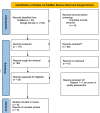Beyond Hormones: A Systematic Review of the Risk of Cardiovascular Diseases in Polycystic Ovary Syndrome
- PMID: 39634976
- PMCID: PMC11616675
- DOI: 10.7759/cureus.72987
Beyond Hormones: A Systematic Review of the Risk of Cardiovascular Diseases in Polycystic Ovary Syndrome
Abstract
Polycystic ovary syndrome (PCOS) is a common endocrinopathy among women in the reproductive age group. PCOS is defined by the Rotterdam criteria, which include hyperandrogenism, oligo-anovulation, and polycystic ovaries on ultrasound. The common symptoms are irregular or absent periods, acne, hirsutism, and alopecia androgenica. Increased prevalence of metabolic syndrome is seen among women with PCOS, which increases cardiovascular risk (CVR). Insulin resistance (IR), being most common in PCOS, is often seen in patients with obesity. IR and obesity induce chronic low-grade inflammation in PCOS, increasing various inflammatory markers. Increase in the parameters of tumor necrosis factor-alpha (TNF-alpha), interleukin-1 (IL-1), interleukin-6 (IL-6), C- reactive protein (CRP), plasminogen, endothelin-1, fibrinogen, cystatin-C, fetuin B, vascular endothelial growth factor, and endostatin levels have been documented in the PCOS-affected women. Microbiota alteration is also seen in this demographic, which increases metabolites like trimethylamine-N-oxide (TMAO). TMAO, because of its pro-atherosclerotic activity, is linked to an increase in CVR. In this systematic review, we intended to discover the causes and factors that lead to increased CVR in women diagnosed with PCOS. This systematic review used PubMed, regular keywords, and Google Scholar. The inclusion criteria included the human female population of all ages and literature available in the English language in free full text published between the years 2019 and 2024. The exclusion criteria included research involving animals, works published before 2019, articles written in a language other than English, and articles not publicly available. A total of 89 articles were identified, and 8 final articles were selected after quality assessment.
Keywords: atherosclerotic cardiovascular disease; endocrine disorders; inflammatory biomarkers; medical screening; metabolic syndrome (mets); polycystic ovary syndrome (pcos); prevention of cardiovascular diseases; public health awareness; risk factors of cardiovascular diseases; stein-leventhal syndrome.
Copyright © 2024, Dutta et al.
Conflict of interest statement
Conflicts of interest: In compliance with the ICMJE uniform disclosure form, all authors declare the following: Payment/services info: All authors have declared that no financial support was received from any organization for the submitted work. Financial relationships: All authors have declared that they have no financial relationships at present or within the previous three years with any organizations that might have an interest in the submitted work. Other relationships: All authors have declared that there are no other relationships or activities that could appear to have influenced the submitted work.
Figures


References
-
- Donma O, Ozturk EZ, Ekmekci OB, Ocal P, Topcu B. Medicina. Vol. 50. 163-167: MEDICINA; 2019. Molecular links between angiogenesis and inflammation in polycystic ovary syndrome; pp. 163–167.
-
- Increased fetuin-B levels are associated with carotid intima media thickness and hormonal-metabolic disturbances in women with polycystic ovary syndrome. Bayındır A, Unal G, İmamoğlu C, Alan Y. Zeynep Kamil Tıp Bülteni. 2020;51:106–112.
-
- The effect of aerobic exercise training on biochemical and inflammatory markers among young females suffering from polycystic ovary syndrome. Jafari S, Taghian F. J Midwifery Reprod Health. 2020;8:2194–2202.
Publication types
LinkOut - more resources
Full Text Sources
Research Materials
Miscellaneous
